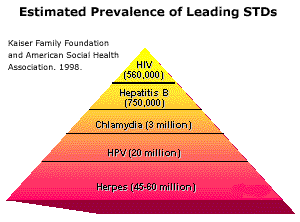How Do You Get Herpes Infections?
Herpes can be spread through skin-to-skin contact or by contact between mucosal surfaces at any time the virus is in its active phase: Viral shedding deposits HSV on the skin or a mucous membrane. Contact with another individual's skin allows virus to spread and begin the job of situating itself in the nervous system of a new host. Herpes virus infection is most often transmitted "unwittingly". That is, from people who do not know they have it or if they know they have it from exposure at times when the virus is shed asymptomatically in saliva or genital secretions. Most of us acquire HSV-1 in childhood by kissing from close adult relatives. Genital herpes is usually acquired through sexual intercourse of some type.
How did I get herpes?
Herpes can be so subtle that even the active phases are sometimes hard to identify. As a result, herpes is often spread during periods when people simply don't recognize the virus has become active. In addition, a person can acquire herpes without recognizing the "first episode."
For these reasons, it's often difficult to trace the source of infection or know exactly when transmission occurred. It appears the efficiency of transmission is higher from contact to a lesion like a cold sore or genital lesion than from "asymptomatic shedding". Thus, sexual contact when one has lesions is discouraged.
How many people have genital herpes?
In the United States 50 � 70% of adults have oral herpes (HSV-1 infection). The highest risk of acquisition is early childhood and adolexcence. But infections are acquired throughout life. Approximately one-quarter of Americans over the age of 15 are infected with genital herpes -- an estimated 45 to 60 million people in the U.S. alone. About 1.5 million new infections of gential HSV-2 infections occur yearly. Herpes simplex virus infections are by far the most common sexually transmitted infection (STI).

These numbers may seem hard to believe. To put them in proper perspective, remember: HSV is usually a very subtle infection. In research studies, less than a third of those infected could easily recognize herpes symptoms. The remainder -- the vast majority -could not. Most people simply don't know they are carriers. This is why the new blood tests which identify antibodies to the HSV-1 and HSV-2 virus in blood and, hence, identify carriers are so useful. In some cases, this is because they have failed to identify some of the milder symptoms of herpes. In others, it's because they apparently have suffered from no symptoms at all.
Herpes is not just a disease of the United Stated. Nearly similar rates of HSV-2 exist in Northern Europe and most of Africa. Some Southern European countries and Eastern countries report some what lower rates roles of HSV-2 (10-20 %), but higher HSV-1 rates (60-80%).
HSV-2 the major cause of genital herpes is a lifelong infection, thus transmission often occurs even among monogamous partners. This usually occurs when one of the partners gets infected unknowingly from a prior relationship, but sheds virus and infects the new partner. The source partner could have been totally asymptomatic or had signs and symptoms so subtle that they were ignored or unrecognized. The new partner may get a symptomatic infection.